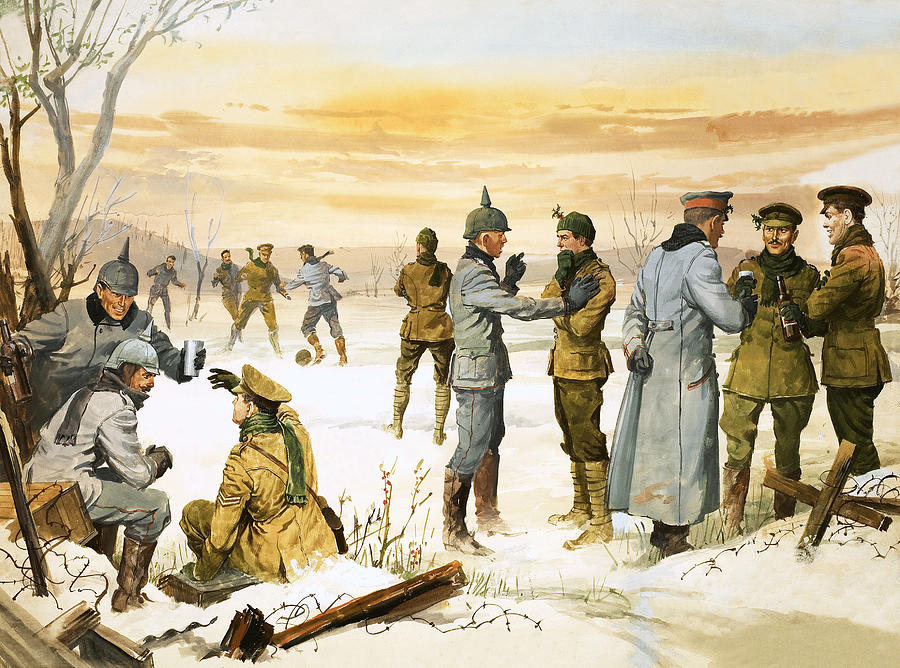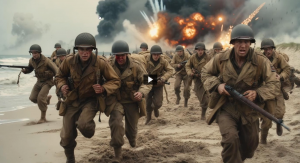The chilling cold was inescapable and constant along the trenches. This was only worsened by the rain-water flooding the muddy walls and floors. Some months had passed since the beginning of World War I, and it was now December of the year 1914. Being “home by Christmas” was out of the question, and a seemingly insuperable stalemate had been reached along the trenches stretching from the Alps to the English channel. The area between these trenches is what was known as “No Man’s Land.” This name was not a novelty in history, but it certainly increased in accuracy since its first usage. Soldiers, young men sometimes as young as fifteen, were dying by the thousands, killed by the indiscriminate fire of the machine gun, a recent addition to the arsenal of armies.1
The Allied Forces had just held off the invading German army along the Marne river, in what was called the “Miracle of the Marne.” The allied victory here signified the failure of the “Schlieffen Plan,” Germany’s attempt at sweeping a 180-degree rotation through neighboring Belgium and France. This strategy would require German troops to rapidly defeat French forces, so that they could be speedily transported via train to what would be the Eastern Front, where Russia would hopefully be slow to mobilize.2

The first trenches were dug on the western front immediately after the Battle of the Marne, which ended on September 12, 1914. The trenches were dug to survive the incoming attacks more easily. However, these trenches would later mark the border into a place of almost certain death.3 The battles of Verdun, the Somme, the Hundred Day Offensive, and Spring Offensive, fought on the Western Front, ended the lives of 5.5 million men. Sixty thousand British soldiers died on the first day of the Battle of the Somme, a death-count still unparalleled in British military history.4
The time in between battles in the trenches was miserable. The 700-kilometer system of parallel trenches was infested with rats, lice, and the bodies of dead horses and men, whom they would stop burying, because the count was so high and because they simply could not reach the bodies without a high risk of losing their own lives in the process. Crosses scattered around the trenches marked the resting places of fallen men, and also provided a grim reminder of the brutality they faced. These insane living conditions led to death by diseases such as dysentery, typhus, or cholera. This place could easily be likened to Hell on Earth. The area between trenches supported this description, a wasteland of barbed wire and tree trunks with no branches.5 Day and night, this is what the men at the front would experience. In fact, the German Expressionist Otto Dix described the trenches eloquently:
“Lice, rats, barbed wire, fleas, shells, bombs, underground caves, corpses, blood, liquor, mice, cats, artillery, filth, bullets, mortars, fire, steel: That is what war is. It is the work of the devil.”6
But then came December. A different feeling was noticeable and written about by the men in the trenches. Sniping had grown rarer, and both French and British soldiers could occasionally hear sentimental singing from the German trenches. Naturally the higher ups thought this to be some sort of tactic by the Germans. Lit up trees would appear, and shortly after, singing would ensue. The French and British soldiers were baffled, because Germans were supposed to be “barbarians.” The Christmas trees that would appear in the not so distant German trenches were somewhat of a novelty to French and British soldiers. However, they were part and parcel of the German Christmas that year.7 Some of the British soldiers shot at the Christmas trees at first, not knowing what to expect. Imagine that after shooting several times at targets near the Germans, they start calling out, promising not to shoot. After months at war, this would not make any sense to war-hardened soldiers.8
A literal calm came on the 4th of December, when an absence of gunfire was reported in some locations. The next day, a royal engineer by the name of Andrew Todd wrote to the Edinburgh Scotsman that soldiers were being “pally” with the enemy. He described their interactions, which included playful cursing at each other, and tossing newspapers from one side to the other, in places separated by only sixty yards. In a card to his mother, one rifleman wrote about how the Germans had peacefully come up and collected some of their wounded, and the British quickly went and collected their own, and after talking, both sides decided to help in burying each other’s dead. The rifleman went on to describe the enemy soldiers as “fine men.” These interactions only increased the closer they got to Christmas. By December 20, both Allied forces and Germans were intent on celebrating Christmas. In preparation of a gift exchange, British forces prepared to give brass boxes, which had been given to them by the crown. These boxes contained cigarettes and pipe tobacco, as well as a greeting card that read “May God protect and bring you home safe.” The Germans, on the other hand, provided some musical entertainment, cigars, and beer imported from as far away as Munich. In a semi-official report, Major Jeffreys provided a description of “A Christmas Onslaught onto the Field-Grey (troops)” as follows:
“Yesterday about Four-o’clock in the afternoon there was a fierce and terrible onslaught of Christmas packages onto our trenches. No man was spared. However, not a single package fell into the hands of the French. In the confusion, one soldier suffered the impaling of a salami two inches in diameter straight into his stomach…. Another had two large raisins from an exploding pastry fly directly into his eyes…. A third man had the great misfortune of having a full bottle of cognac fly into his mouth.”9
Enemies were “fraternizing” with each other. Men who had been killing each other the previous four months, living in disease-riddled trenches, were singing together, playing soccer, getting drunk, throwing down their guns and smoking a cigar or two.10 The Brits sang ‘cheeky’ songs, eventually followed by Christmas carols, and “God save the King,” and the Germans sometimes sang too, accompanied by musical instruments.11 Christmas trees adorned the trenches, and a true spirit of Christmas had possessed these men, a true miracle really.
But the year was 1914, and the war would last until 1918. The continuation of the war would eventually return, because of people like Captain Rudolf Binding, a Hussar who in a letter complained to his father that if he were in power, Christmas would be banned for the year. Measures taken to resume the war, included the banning of future fraternizations with the enemy and an increased pressure on generals to end the peace, in some cases by making the men believe that the truce was part of a nefarious plan by the enemy. This eventually led to more killing, however, in a less eager manner.12 Upon the setting of the sun on Christmas day, one soldier in St. Yvon, twenty-six-year-old Lieutenant Charles Bruce Bairnsfather described a feeling that “It was just the sort of day for peace to be declared.” He talked about wishing that a telegraph boy would reach him with a letter from the King telling the troops that the war is off, and to go back home.13 That day did not come soon.
It is important to note that this truce was informal, and did not only include a single truce but several throughout the trenches. It is said that one similar, yet much less enthusiastic truce was struck in 1915. However, by that time, the propaganda on the barbarity of the Germans had been spread more aggressively.14 There was peace, but not only peace. In one of the most inhumane wars in history, individual men crossed the place called “No man’s land” and shook their enemy’s hand. They complained about the damn war, and wished each other a Merry Christmas.

- Stanley Weintraub, Silent Night (Free Press, 2001), 9; John Keenan, An Illustrated History of the First World War (Alfred A Knopf, 2001), 170. ↵
- Terrence M. Holmes, Absolute Numbers: The Schlieffen Plan as a Critique of German Strategy in 1914 (Sage Publications, Ltd. 2014), 197-199. ↵
- John Keenan, An Illustrated History of the First World War (Alfred A Knopf, 2001), 180. ↵
- The Oxford Companion to British History, 3 Apr. 2018, s.v. “Somme, Battle of the,” by David French. ↵
- Jay Winter, The Legacy of the Great War-Ninety Years On (University of Missouri Press), 26-27. ↵
- Stanley Weintraub, Silent Night (The Free Press 2001), 2. ↵
- Modris Eksteins, Rites of Spring (New York: Houghton Mifflin Harcourt, 2000), 110-111. ↵
- Kathryn N. McDaniel, Commemorating the Christmas Truce: A Critical Thinking Approach for Popular History (Society for History Education), 92. ↵
- Stanley Weintraub, Silent Night (Free Press, 2001), 11. ↵
- Stanley Weintraub, Silent Night (Free Press, 2001), 9. ↵
- Kathryn N. McDaniel, Commemorating the Christmas Truce: A Critical Thinking Approach for Popular History (Society for History Education), 92. ↵
- Michael S. Neiberg, Fighting the Great War- A Global History (Harvard University Press, 2006), 70. ↵
- Stanley Weintraub, Silent Night (The Free Press, 2001), 16. ↵
- Kathryn N. McDaniel, Commemorating the Christmas Truce: A Critical Thinking Approach for Popular History (Society for History Education), 92-91. ↵



126 comments
Richard Morales
This story is very interesting. I would never think in the history of World War 1 to hear a story of allied forces celebrating Christmas with the enemies. It shows the meaninglessness of war was to most soldiers. All these men could get a long but they are fighting for the men in charge of their own nations. I’m sure those few days of no gunfire felt like heaven in hell on earth. It is heartwarming to hear that these soldiers both gave the other side a break in the spirit of Christmas.
Michael Hinojosa
I remember learning about this in my history class and was honestly baffled to know that even in the darkest times of war both sides were able to put down their weapons for one day and simply get to act as normal human beings enjoying each others company, not soldiers of war trying to kill each other for their own causes. This article did a fantastic job with the setup and backstory as well, making for an informative read that wasn’t too hard to understand!
Enrique Segovia
This article was inspiring for me because it proved that even in the darkest times of mankind, some sort of humanity sparked on that Christmas Day of 1914. The Christmas Day Truce of 1914 should be recognized more and it should be taught in school to teach students that even at war, the soldiers of opposing sides can dig deep enough and find some tranquility and peace amongst them to stop fighting to celebrate together a special holiday. I was cognizant of this event because I had read in in a Twitter or Instagram post, and I also had watched a movie where I felt the same inspiration as I felt due to this article, arising from the humanity each of the soldiers had in them to stop fighting on Christmas Day of 1914 and be peaceful.
Martina Rodriguez
The article does a very good job of explaining the background of the story: where and what was happening in the war at this point in time. The author does an amazing job of utilizing details to effectively paint the grisly pictures of what life in the trenches looked like for the soldiers. The quote by Otto Dix further solidified the terrifying reality. It is impossible to believe the extent that the spirit of Christmas had on the battle hardened men. The author is right in their saying “it was nothing short of a miracle”
Luke Lopez
This was a very interesting article on the Christmas Day Truce of 1914. Men on both sides were tired of fighting in the war, and wanted time to celebrate Christmas. These soldiers just so happened to celebrate Christmas with each other, and they even exchanged gifts with the opposing side. It is great that these men were able to come together and celebrate something that they have in common.
Nathan Alba
I thought this article did well to bring a sense of kindness to a gruesome period in history. To show that although people are willing to fight and die for their country, they are not terrible human beings. This article shows that everyone, even the enemy, has the capability of being good. Even if it is just for one day, at least these troops got to experience some sort of humanity, before being asked to take up arms again.
Mariah Garcia
Christmas itself is a wonderful day of the year. A day to get together, enjoy each other’s company, and just be with family. Sadly, the soldiers in World War I didn’t have the option to see their families or even get to sit in their favorite seat, at home, for Christmas in 1914. They were at war but this one day of truce was a beautiful moment during the war. It was unwritten, but it will always be a memory of those who lived through the war and were able to tell others about it.
Madison Downing
This article was so beautiful it brought tears to my eyes. When normal people think or the war they only see the destruction, the lifeless, and the marks that scar the Earth, I would have never thought that something this unique would happen. Both sides coming to celebrate Christmas, how amazingly tragic that is because then the next day they would have to go back to trying to kill the other. I could just image the men slowly walking across No-Man’s land and hugging the enemy soldiers. It is disgusting how men like Captain Rudolf Binding would try and take away the only happiness these men have felt in all their time fighting the war. Some not by choice. This was so fantastic to read I truly loved the obvious work you poured into this article, you should be extremely proud!
Sienna Guerra
This article caught my attention since I love the Christmas holiday season! I like knowing that there are times that bring job and comfort within the dark time such as war. Men of both sides of the “Great War” deserved a few days of peace after the chaos. The inspiring part of this article is that even though they were in a battle against each other, these few days made the soldiers realize that at the end of the day, they are all soldiers and they all deserved just one last hurrah!
Engelbert Madrid
The day that never comes. You want change, you want love and freedom, yet the one with power feeds it to the rich dogs, pretending that everything is fine. It is sad knowing that young men died in vain, because their country’s leaders would not give up their power and glory. The way these soldiers in World War I celebrated in unanimous during Christmas is tremendously touching, something that all human beings should remember.